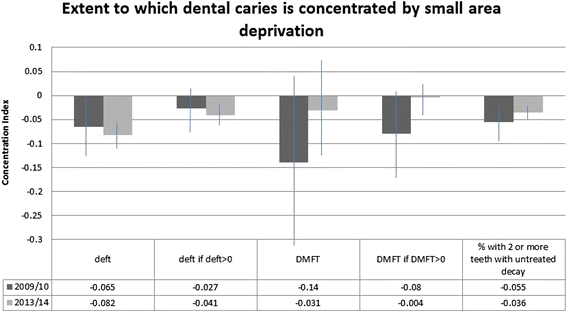Equity in children's dental caries before and after cessation of community water fluoridation: differential impact by dental insurance status and geographic material deprivation
- PMID: 26864565
- PMCID: PMC4750250
- DOI: 10.1186/s12939-016-0312-1
Equity in children's dental caries before and after cessation of community water fluoridation: differential impact by dental insurance status and geographic material deprivation
Abstract
Background: One of the main arguments made in favor of community water fluoridation is that it is equitable in its impact on dental caries (i.e., helps to offset inequities in dental caries). Although an equitable effect of fluoridation has been demonstrated in cross-sectional studies, it has not been studied in the context of cessation of community water fluoridation (CWF). The objective of this study was to compare the socio-economic patterns of children's dental caries (tooth decay) in Calgary, Canada, in 2009/10 when CWF was in place, and in 2013/14, after it had been discontinued.
Methods: We analyzed data from population-based samples of schoolchildren (grade 2) in 2009/10 and 2013/14. Data on dental caries (decayed, missing, and filled primary and permanent teeth) were gathered via open mouth exams conducted in schools by registered dental hygienists. We examined the association between dental caries and 1) presence/absence of dental insurance and 2) small area index of material deprivation, using Poisson (zero-inflated) and logistic regression, for both time points separately. For small-area material deprivation at each time point, we also computed the concentration index of inequality for each outcome variable.
Results: Statistically significant inequities by dental insurance status and by small area material deprivation were more apparent in 2013/14 than in 2009/10.
Conclusions: Results are consistent with increasing inequities in dental caries following cessation of CWF. However, further research is needed to 1) confirm the effects in a study that includes a comparison community, and 2) explore possible alternative reasons for the findings, including changes in treatment and preventive programming.
Figures
References
-
- Canada H. Report on the findings of the oral health component of the Canadian health measures survey, 2007–2009. Ottawa: Minister of Health; 2010.
-
- Broomhead T, Baker SR, Jones K, Richardson A, Marshman Z. What are the most accurate predictors of caries in children aged 5 years in the UK? Community Dent Health. 2014;31(2):111–6. - PubMed
Publication types
MeSH terms
Substances
Grants and funding
LinkOut - more resources
Full Text Sources
Other Literature Sources


